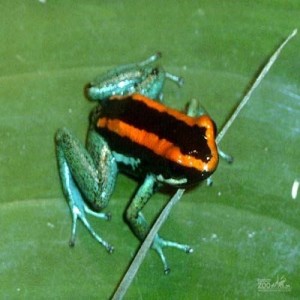 Golfodulcean poison dart frogs measure just 1.0 to 1.4 inches in length. Their back and head are solid black with orange or yellow stripes that run from either side of the snout, and over their back to the thigh. The dorsal (back) surface and limbs are generally blue green with black speckling. These colors function as a visual warning, a learned response on the part of the predator. They capture their prey with sticky, retractable tongues. It is believed that poison frogs gain their poison from arthropods and other insects they eat in the wild and that these insects most likely acquire their poison from their plant diet. Habitat loss from forest clearing, water pollution and collection for the pet trade are their biggest threats.
Golfodulcean poison dart frogs measure just 1.0 to 1.4 inches in length. Their back and head are solid black with orange or yellow stripes that run from either side of the snout, and over their back to the thigh. The dorsal (back) surface and limbs are generally blue green with black speckling. These colors function as a visual warning, a learned response on the part of the predator. They capture their prey with sticky, retractable tongues. It is believed that poison frogs gain their poison from arthropods and other insects they eat in the wild and that these insects most likely acquire their poison from their plant diet. Habitat loss from forest clearing, water pollution and collection for the pet trade are their biggest threats.
Location: The Lower RainForest
Share:
Range
Costa Rica
Habitat
The Golfodulcean Posion Dart Frog is endemic to Costa Rica, inhabiting the wet forests and lowlands of the Golfo Dulce region in the southwestern part of Costa Rica. This species is found between 65 to 1800 feet in elevation. It prefers the leaf litter of forested valleys with streams. Habitat loss from forest clearing and tree plantations and water pollution from mining and collection for the pet trade are their biggest threats.
Conservation Status
Vulnerable
Primary Threats
Human Wildlife Coexistence, Climate Change
Gestation
15 days
Litter
7- 21 eggs
Behavior
They are a diurnal, terrestrial species. They are shy and will hide in rock crevices or holes between tree roots when approached.
Reproduction
During breeding season the female lays clutches every week or two. Eggs are deposited on leaves about the ground. The male then visits the eggs to fertilize them. Froglets are sexually mature at about 10 months.
Wild Diet
They feed on small insects including ants, termites, flies, beetles and mites.
Zoo Diet

